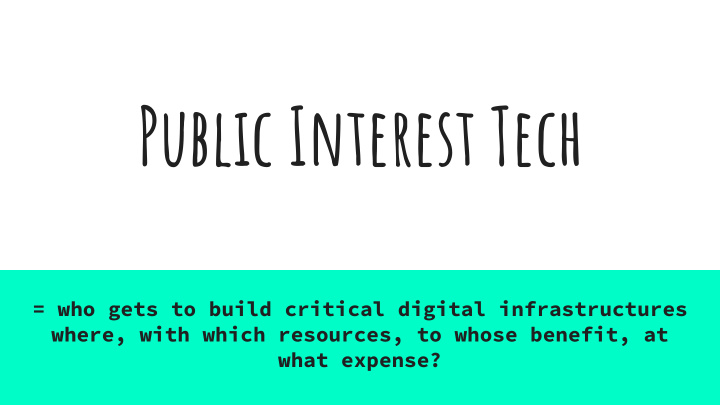



Public Interest Tech = who gets to build critical digital infrastructures where, with which resources, to whose benefit, at what expense?
Why am i here? Mostly: https://medium.com/@katharina.meyer/von-moonshots-und-protot ypen-oder-public-interest-tech-what-goes-up-must-trickle-dow n-b1c6bbfeda77
Very brief Summary in Keywords 50 years of moonshot only possible bc of heavy public ● investment in space exploration, accompanying innovations and trickle-down effects, as well as PR. It´s nice that we have all of these fancy technologies ● like gore-tex jackets and Soylent. At this point in time, what could be the technologies that we need most urgently, are these always achieved through disruption or incremental innovation, who gets to innovate for what purposes and at whose expense, and how could the existing narrative be problematic for society as a whole?
“Innovation” First of all, meaning of the word is in flux. ● As we know it, it overemphasizes the value of “new ● things” over maintenance, it is closely connected with intellectual property and the practice of clearing the market and handing over former state resposibilities to the private sector. Don´t want to preach the Gospel of FOSS too much (since ● it has its problematic sides, but): innovation culture based on a system of strange&ridiculous patents, “claims matter above everything else” = patents can be weapons&signals.
Important take-aways What does public interest mean and how do we measure it ● in regards to impact of an innovation and how much public resources we want to spend on these? Also: do you all know Marianna Mazzucato, the Institute ● for innovation and public purpose and her book “The Entrepreneurial State”? And why does the reporting on current technologies (in opposite to the history of the Internet and DARPA-Net) focus on “geniuses” that don´t pay their taxes and lack real academic oversight and accountability mechanisms in their endeavours instead on people who build f.i. community-networks?
Public Interest Technologies & their complicated Relationship with Innovation Innovation: who dis? Do innovations have to be technology? (Hint: No!) ● Innovation vs. Maintenance ● Peer-production vs. intellectual property ● The concept of affordances: Public Interest/Good vs. ● “Opportunities for revenue” The one vs. the many: what& why is an innovator / ● entrepreneur / engineer?
Why am i Interested in this? 1) Dayjob: Head of Research,Prototype Fund (prototypefund.de) Public funding programme for ● FOSS-Software projects that have a benefit for society, run by Open Knowledge Foundation Germany. Was born also because We identified serious lack of resources For people offering services that even the state relies on.
2) Project: Implicit Development Environments - project; Ford Foundation (implicit-development.org) (with Elisa Lindinger & Julia Kloiber) We research the Implicit Development Environments of digital “open infrastructure”& its maintainers, especially Motivations, values, decision-making, inclusion&exclusion mechanisms and the impact of technical standards.
3) I´ve STUDIED STS, so i Should be. ...and you should, too. Hypothesis 1 : The many unintended/negative consequences of technology that we get to witness on a daily basis are also a byproduct of the age of privatization of development&maintenance of innovation and tech infrastructure. R&D situated with companies is bound to initiate other affordances that come with innovations than f.i. Uni labs of community tech, bc.: need to achieve different design goals.
Hypothesis 2: This is not a new problem. But if we don´t fix the narratives about innovation & how we finance and organize R&D into emergent technologies; the urgent need of inclusion of expertise and needs of civil society, we waste (natural.. ect.) resources, nourish problematic technical capabilities, driven by revenue (needs) rather than actual societal challenges and reinforce images of “innovators” and diminish accountability mechanisms and access to critical infrastructure.
Hypothesis 3: Windows of opportunity for states (&maybe third sector) Budget accordingly to the real cost of technologies and their ● implementation, recreate narratives about what innovation is, reallocate access to knowledge and resources to include (technical) communities & education biographies outside of the box (but don´´ think you can “fix” that in universities, our average dev starts age 14. Rethink your approach to procurement & Innovation policy/ funding ● Tax and fine GAFAM (trustable tech & anti-trust policy goes well together) ●
Existing cool Initiative (by Doteveryone)
Takeaways Against commodification of technologies, pro Commons. ● Against rockstars, pro teamwork: peer production and ● transparency instead of inventions that can be monopolized& sold. No alienation of innovation from communal practises. Against ethical frameworks, pro regulation. ● Critical digital infrastructure should be seen and ● financed as modern “roads&bridges” - taxes should be used to maintain them, keep them secure, open, available. Learn from the narrative of how microwaves gradiently ● became from a symbol of progress and convenience to a danger to health and vitamins.
Open Questions(...At least For Me) What could be the metrics of “public interest” be? ● What practices and programs, laws can help ● implement/safeguard this framework, who are the stakeholders? Where shouldn´t the state be involved and how do we ● secure enough other R&D funds that come without ties? How do we get away from the “one solution that fits all”- ● idea and back to decentralozation of services. Should i write a PhD about this? ● WHAT ARE YOUR QUESTIONS ; EXPERIENCES; IDEAS? ●
And last but not least: shameless Advertisement Plug APPLY!
Possible TopiCS: OSINT, Security, Transparency-ToOls
Recommend
More recommend